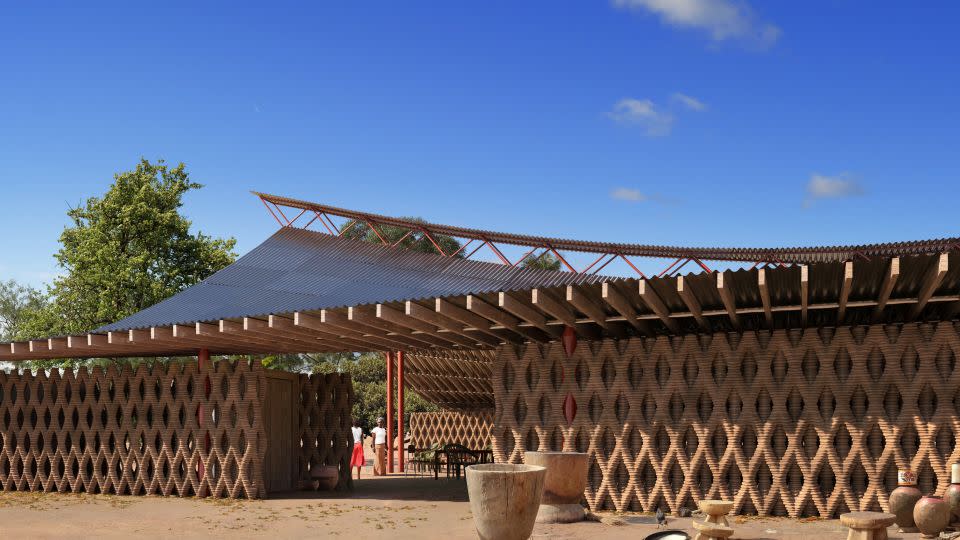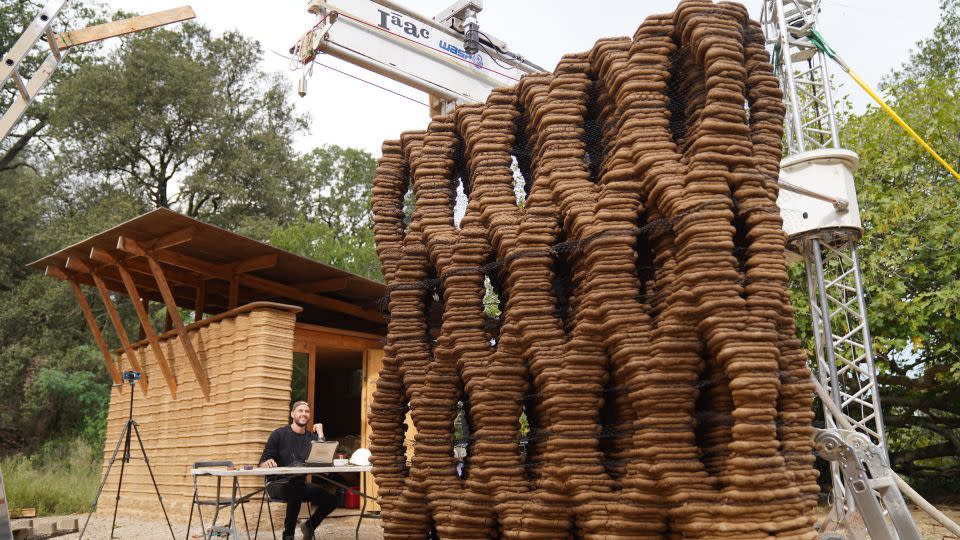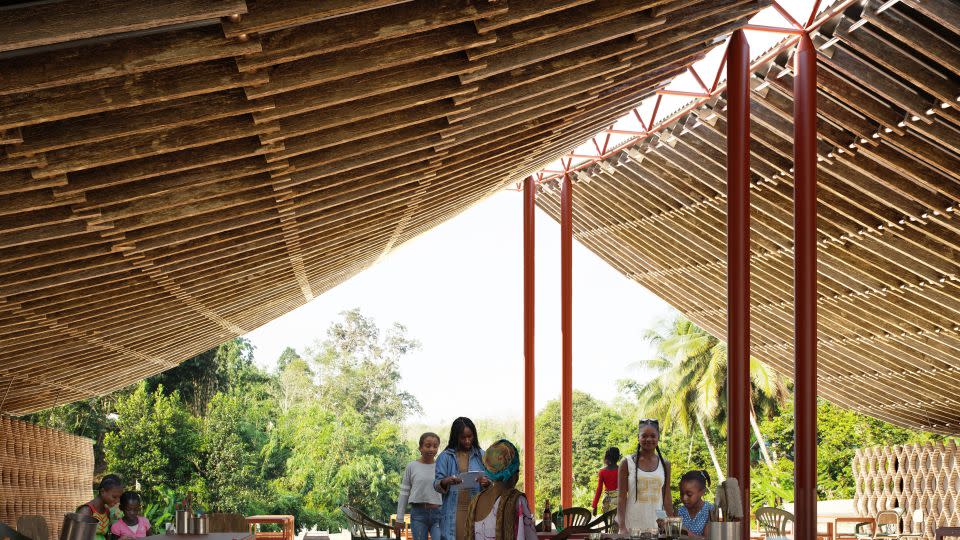Building with 3D printers has matured rapidly in recent years, as advances in technology and materials science have allowed for larger-scale and more ambitious designs. The potential applications have also become increasingly diverse, from affordable housing to a planned NASA base on the moon.
Most 3D-printed structures are built with concrete or other pourable, cement-like substances, which are cheap, reliable, and durable—though they almost always come with a hefty carbon footprint. But an emerging development in the field may offer a more sustainable approach: 3D printing with soil.
In Kibaha, Tanzania, just west of the capital Dar es Salaam, a group of pioneering architects are building a new village with ‘earth pressure’ at its core.
Hope Village is an initiative by architectural firms Hassell and ClarkeHopkinsClarke, together with the charity One Heart. It aims to help and provide shelter to children from across the country who are living in difficult circumstances or in an unsafe home situation.
The village will provide education for up to 480 children, as well as housing, childcare and skills training for dozens of vulnerable girls aged 3 to 18. Nearly 50 buildings are planned for the site, and the land purchased will also include areas for agriculture and livestock, sports and recreation.
Hope Village’s signature building is the community center, a 3D-printed design that serves as a school hall and cafeteria during the week and is open for community events on weekends.

The architects knew they wanted to use locally sourced earth for the community center, but they were concerned about the limitations of rammed earth, which is normally compacted into thick, flat walls.
“We wanted to make sure we could create walls that could ventilate the building but at the same time let light in,” Xavier De Kestelier, Hassell’s head of design and innovation, said in a video call with CNN.
Using 3D printing, an open, “porous” wall design has been made possible, which has already been prototyped up to a height of 2 meters (6.6 feet) by Hassell’s partner, the Institute for Advanced Architecture of Catalonia (IAAC) in Barcelona, Spain.
The walls will be built with soil mined within 25 kilometers (15.5 miles) of the site, Hassell said, and will include a thin mesh between layers for reinforcement. The soil suitable for printing typically contains 15 percent to 30 percent clay, which gives it natural bonding properties, though De Kestelier said the architects haven’t yet decided whether to add an adhesive to the mix.
The walls will not be load-bearing, as a metal structure will support the cantilevered roof that covers the walls and protects them from the elements. The roof will be made from short lengths of locally sourced timber, connected in an interlocking design on the ground before being lifted and “draped” over the frame like a fabric tent and finished with sheet metal, De Kestelier explained.
Vernacular design, modern technology
Building with earth dates back to prehistoric times and has taken many forms, including adobe, mud brick, and rammed earth. 3D printing with earth was first attempted in 2018, and the first 3D printed house made entirely of earth, called TECLA, was designed by Mario Cucinella Architects and built near Ravenna, Italy in 2021.
These structures, like any building made without rebar or steel framing, rely on shapes with strong structural integrity. That often means curves, whether they’re arches, vaults, rotundas, or domes (think Rome’s Pantheon, still the world’s largest unsupported dome nearly 2,000 years later). In Tanzania, the printer will build up layers of compacted soil into interconnecting curved columns, leaving negative space for light and air to filter through.


In addition to form, a key challenge when working with earth is technical durability. Concrete is a resilient material that can withstand the elements; earth less so. But De Kestelier emphasizes that when it comes to 3D-printed architecture, “we don’t need to use more concrete” and that more sustainable options are the future — if used correctly.
The cantilevered roof for the Tanzanian community centre will be vital to protect the walls from the erosive effect of rain, and Hassell said he was encouraged by a visit to the IAAC’s 2022 TOVA project, the first 3D-printed earth building in Spain. “These walls can actually last a very long time,” De Kestelier said.
Given the technology’s novelty, some experts have raised concerns about how 3D-printed buildings will fare in the long term, while others have raised potential “legal gray areas” regarding building codes and regulations, which vary from country to country and are often highly localized. Even the engineer who pioneered 3D-printed construction told the New Yorker last year that “all the hype is unwarranted.” Defenders of the technology, meanwhile, say it offers a fast and efficient way to build homes and other low-rise buildings at a time when even some of the most economically advanced countries are facing housing shortages.


Immediate inheritance
The Hope Village project is being built using the €160,000 Crane WASP printing system used for both TOVA and TECLA.
“The plan is not just to use technology, but to bring technology to the site in Tanzania and leave it there,” De Kestelier said. As part of the project’s commitment to community outreach and skills training, the builders will teach locals how to use the printer so the community can build more buildings in the future.
The approach is similar to another of Hassel’s projects, the Bidi Bidi Music and Arts Centre in northern Uganda, which employed local people to make compressed earth bricks for the refugee community building.
Hope Village is more ambitious, said Mark Loughnan, Hassell’s director and head of design. “It’s (our) first attempt (at) what we hope will prove to be a successful methodology,” he said, adding that the model could one day be replicated in other locations.
For Dr. Consola Elia, who will oversee the children’s home at Hope Village, the project is “the reality of a dream I have had for over 20 years,” she said in a statement.
Work on the master plan has already started. The housing construction is already in full swing and the construction of the community centre is expected to start in early 2025.
“We’re using (design) to improve the way people experience their daily lives,” Loughnan said. “We’re using it in this case to hopefully help, heal and educate — and we’re also using it to innovate at the same time.”
For more CNN news and newsletters, create an account at CNN.com